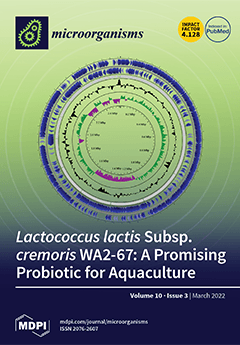The intracellular pathogen
Shigella flexneri, which is the causative agent of bacillary dysentery, significantly influences the worldwide implication of diarrheal infections, consequentially causing about 1.1 million deaths each year. Due to a nonavailability of an authorized vaccine and the upsurge of multidrug
[...] Read more.
The intracellular pathogen
Shigella flexneri, which is the causative agent of bacillary dysentery, significantly influences the worldwide implication of diarrheal infections, consequentially causing about 1.1 million deaths each year. Due to a nonavailability of an authorized vaccine and the upsurge of multidrug resistance amongst
Shigella strains, there has been a huge demand for further genetic analyses which could help in the advancement of new/improved drugs, and finding vaccine candidates against the pathogen. The present study aims to illustrate the role of the
yfiB gene in
Shigella virulence, part of the periplasmic YfiBNR tripartite signalling system. This system is involved in the regulation of cyclic-di-GMP levels inside the bacterial cells, a vital messenger molecule impacting varied cellular processes such as biofilm formation, cytotoxicity, motility, synthesis of exopolysaccharide, and other virulence mechanisms such as adhesion and invasion of the bacteria. Through a combination of genetic, biochemical, and virulence assays, we show how knocking out the
yfiB gene can disrupt the entire YfiBNR system and affect the native c-di-GMP levels. We found that this subsequently causes a negative effect on the biofilm formation, bacterial invasion, host–surface attachment, and the overall virulence of
Shigella. This study also carried out a structural and functional assessment of the YfiB protein and determined critical amino acid residues, essential for proper functioning of this signalling system. The present work improves our understanding of the in vivo persistence and survival of
Shigella, brings light to the c-di-GMP led regulation of
Shigella virulence, and provides a prospective new target to design anti-infection drugs and vaccines against
S. flexneri and other bacterial pathogens.
Full article






